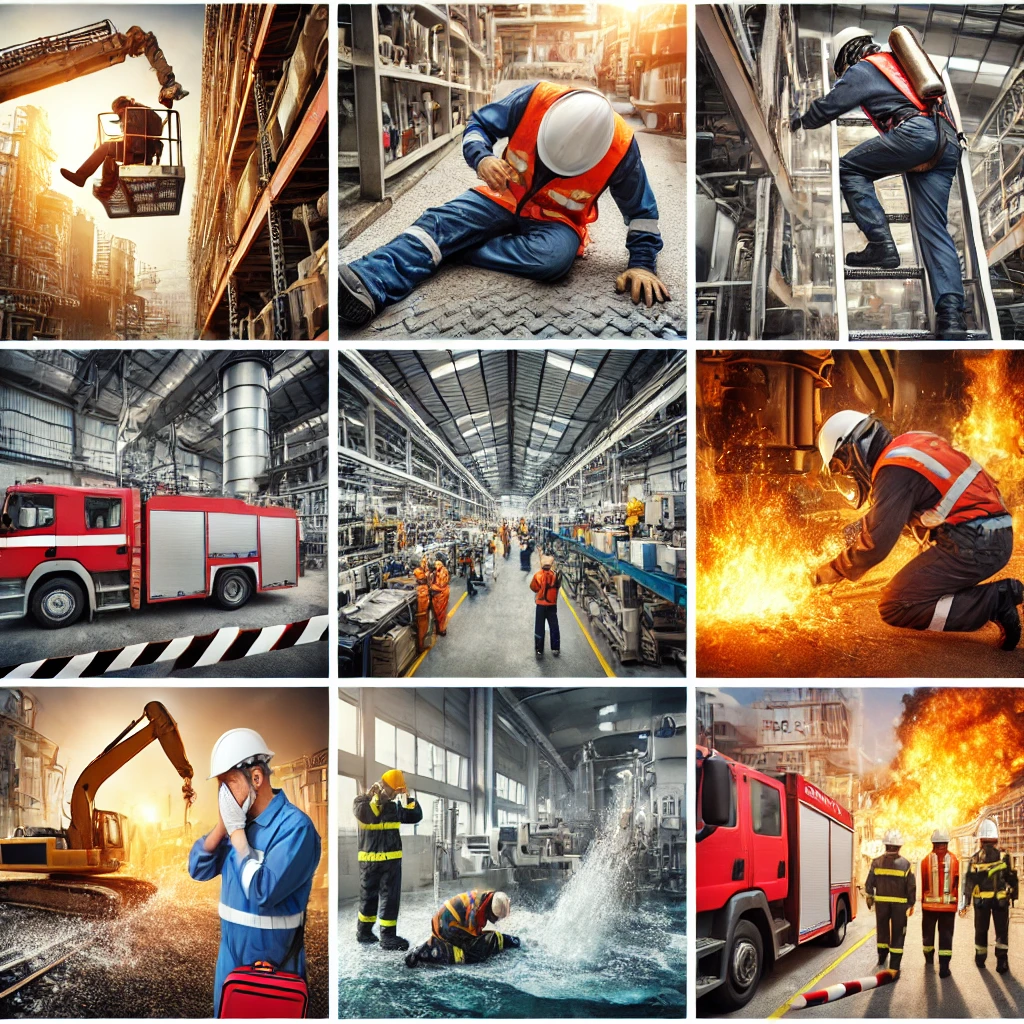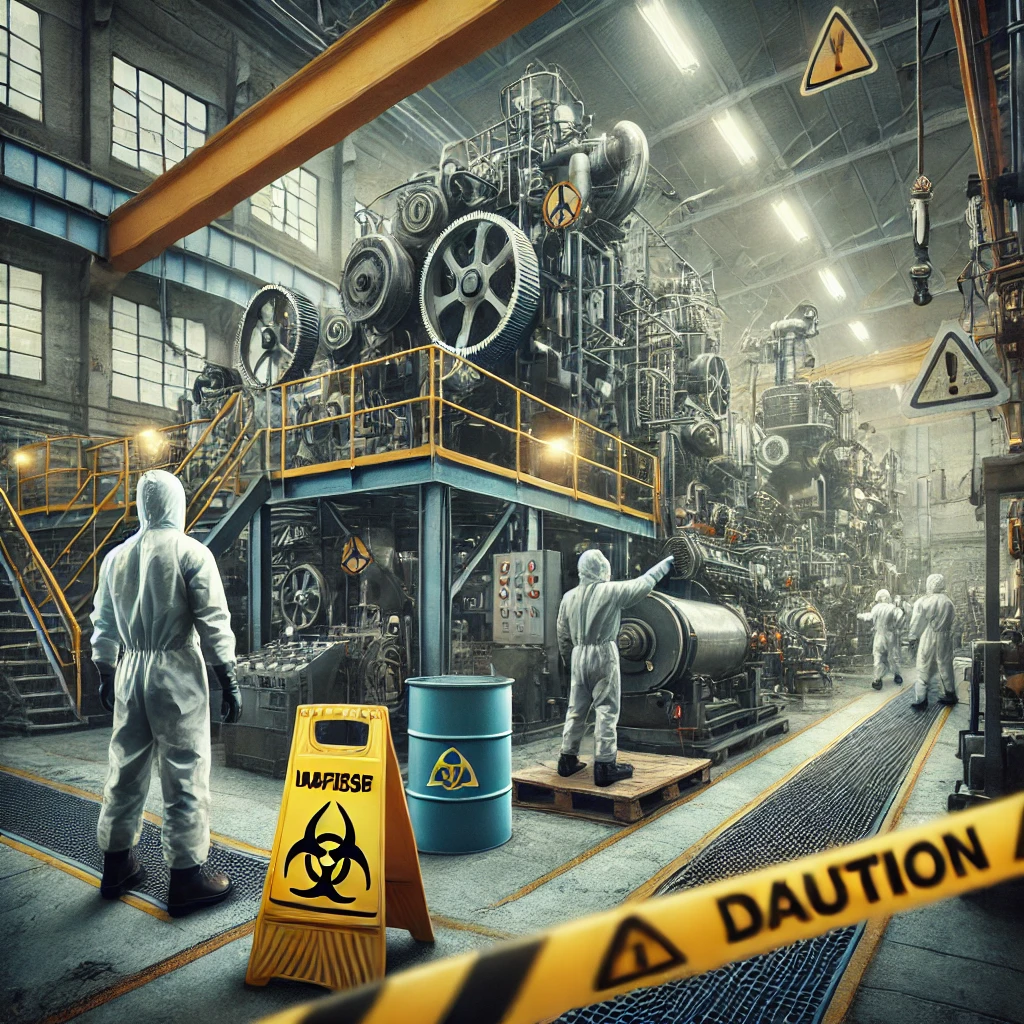Top 10 Questions About Industrial Accidents: Answers and Insights
Industrial accidents can have serious repercussions for employees, employers, and even third-party entities involved in workplace activities. These incidents raise many questions about liability, compensation, safety, and legal responsibilities. Here, we answer the top 10 questions people frequently ask about industrial accidents, providing essential information for workers and employers alike.
1. What is considered an industrial accident?
An industrial accident refers to any injury, illness, or fatality that occurs in an industrial or manufacturing setting. This includes incidents involving heavy machinery, chemical exposure, falls, explosions, or any work-related activity that results in harm. These accidents typically occur in factories, plants, construction sites, and other high-risk environments. To qualify as an industrial accident, the incident must occur while an employee is performing work-related duties or on the employer’s premises.

2. Who is liable in an industrial accident?
Liability in industrial accidents can vary. In most cases, the employer holds primary responsibility if the accident occurred due to unsafe working conditions, lack of training, or failure to adhere to safety regulations. However, third parties, like equipment manufacturers or contractors, may be liable if a malfunction or defect contributed to the accident. In cases where employer negligence or regulatory violations are involved, they could face legal action from injured employees or regulatory bodies.
3. What should I do immediately after an industrial accident?
Immediately after an industrial accident, follow these steps:
- Seek Medical Attention: Prioritize medical care, even for injuries that seem minor, as some injuries might not be immediately apparent.
- Report the Incident: Notify your supervisor or manager about the accident as soon as possible, as this is often required by company policy and workers’ compensation law.
- Document the Scene: If you’re able, take photos of the accident site, any damaged equipment, and your injuries.
- Collect Witness Information: Gather contact information from any witnesses who saw the accident.
- File a Report: Submit an official report as soon as possible, and keep a copy for your records.
Taking these steps can help protect your rights and create an accurate record of the incident.
4. Can I sue my employer for an industrial accident?
In most cases, employees cannot sue their employers directly due to workers’ compensation laws, which protect employers from lawsuits by offering guaranteed benefits to injured workers. However, exceptions exist. If an employer acted with gross negligence or intentionally created unsafe conditions, the employee may be able to pursue a lawsuit. Additionally, if a third party, like a subcontractor or equipment manufacturer, was involved, the injured worker might file a lawsuit against that party.
5. How much compensation can I receive for an industrial accident injury?
Compensation for industrial accident injuries can vary greatly, depending on factors like the severity of the injury, medical expenses, lost wages, and pain and suffering. Here’s a general breakdown:
- Minor Injuries: Typically $10,000–$100,000, covering medical bills and short-term lost wages.
- Severe Injuries: Injuries that impact long-term work capabilities, such as a severe burn or spinal injury, may lead to compensation from $100,000 to several million dollars.
- Fatalities: Wrongful death claims often result in higher settlements to cover loss of income, funeral expenses, and pain and suffering for the family.
The exact amount depends on the type of claim (workers’ compensation vs. personal injury) and whether the case involves punitive damages.
6. What are common causes of industrial accidents?
Industrial accidents typically arise from:
- Lack of Safety Training: When employees aren’t properly trained, the risk of misuse of equipment or overlooking safety protocols increases.
- Faulty Equipment: Poor maintenance or equipment defects can lead to severe injuries.
- Inadequate Supervision: Lack of proper oversight may result in unsafe work practices.
- Hazardous Environments: Exposure to toxic chemicals, slippery surfaces, or high temperatures increases accident risk.
- Human Error: Fatigue, distraction, and poor decision-making are common in high-stress industrial environments.
Understanding these causes is key to prevention, which is why OSHA and other regulatory bodies mandate specific safety practices in industrial settings.
7. What legal protections exist for workers injured in industrial accidents?
In the U.S., workers have several protections under federal and state laws:
- OSHA (Occupational Safety and Health Administration): OSHA sets and enforces standards to ensure workplace safety. It also gives workers the right to report unsafe conditions without fear of retaliation.
- Workers’ Compensation: Almost all states require employers to provide workers’ compensation, which covers medical expenses and a portion of lost wages.
- ADA (Americans with Disabilities Act): If an industrial accident results in a disability, the ADA protects the employee from discrimination and may require employers to provide reasonable accommodations.
These protections aim to support workers’ rights, provide compensation, and enforce safe practices in the workplace.
8. How long does it take to resolve an industrial accident claim?
The timeline to resolve an industrial accident claim varies, depending on the severity of the injury, the complexity of the case, and the cooperation of insurance providers.
- Workers’ Compensation Claims: These are often resolved within a few weeks to months if uncontested.
- Personal Injury Lawsuits: For more serious cases, especially if there’s significant disagreement, a case can take 1–3 years or more to settle.
- Third-Party Lawsuits: If a third-party manufacturer is involved, the claim may take longer due to the complexity of product liability cases.
Timelines are typically shorter if the parties agree to a settlement rather than going to trial.
9. Can I get compensation for mental trauma from an industrial accident?
Yes, many industrial accident claims include compensation for mental trauma. This could involve compensation for conditions like post-traumatic stress disorder (PTSD), anxiety, or depression resulting from the incident. To receive compensation for emotional or psychological injuries, an employee typically needs to document the mental health impact and may need to provide evidence, such as medical records or a psychologist’s evaluation.
10. What steps can employers take to prevent industrial accidents?
Employers can take several proactive steps to minimize the risk of industrial accidents:
- Regular Safety Training: Frequent training ensures that employees are aware of safety protocols and know how to operate equipment safely.
- Routine Equipment Maintenance: Keeping machinery and equipment in good condition reduces the risk of malfunctions.
- Proper Supervision: Ensuring adequate oversight can prevent unsafe practices from taking place.
- Clear Safety Policies: Policies should address procedures for handling hazardous materials, using protective gear, and reporting unsafe conditions.
- Encourage Reporting: Allowing employees to report safety concerns without fear of retaliation can help identify and address issues before they lead to accidents.
Employers that prioritize a culture of safety, backed by proper training and adherence to OSHA standards, significantly reduce the likelihood of accidents and liability.
By understanding these frequently asked questions and their answers, both employees and employers can navigate industrial safety and accidents more effectively. Awareness of rights, responsibilities, and protections is essential for fostering safer, more supportive workplaces.
How Much Can People Make from Industrial Accident Lawsuits? A Guide to Compensation and Payouts
Industrial accidents can be life-altering, causing physical injuries, psychological trauma, or even the tragic loss of life. When these incidents occur, affected employees and their families often seek financial compensation through legal action. The amount people can make from industrial accident lawsuits varies widely, depending on factors like the severity of the injury, the level of negligence, and the specifics of the claim. In this post, we’ll break down potential compensation amounts, types of damages awarded, and how payouts are typically made.
1. Determining the Value of Industrial Accident Settlements
The compensation awarded in industrial accident cases is designed to cover medical expenses, lost wages, pain and suffering, and, in some cases, punitive damages. While settlement amounts vary greatly, they can range from a few thousand dollars to millions. Here are a few key factors that influence the value of a claim:
- Severity of the Injury: Serious injuries, like permanent disabilities, severe burns, or loss of limb, typically result in higher settlements. The more life-altering the injury, the greater the compensation.
- Extent of Employer Negligence: If an employer is found to have shown gross negligence, such as by ignoring safety regulations or failing to fix known hazards, this can increase the compensation significantly.
- Long-Term Impact: Injuries that have long-term effects on a person’s ability to work or live independently often result in higher payouts. This includes costs for ongoing care, rehabilitation, and loss of future earning potential.
- Type of Claim: Whether the claim is a workers’ compensation claim, a personal injury lawsuit, or a wrongful death suit affects the amount and type of damages awarded. Personal injury and wrongful death lawsuits usually yield higher payouts than workers’ compensation claims.
2. Types of Compensation Available in Industrial Accident Lawsuits
In industrial accident cases, compensation may be categorized into economic, non-economic, and punitive damages. Here’s how each type contributes to the total payout:
a. Economic Damages
Economic damages cover measurable financial losses related to the injury. These may include:
- Medical Expenses: This includes immediate medical costs and future medical needs like surgeries, physical therapy, and medication.
- Lost Wages: If the injury results in time away from work, lost wages can be compensated. If the injury affects the ability to work in the future, loss of earning capacity may also be included.
- Rehabilitation Costs: Injuries often require ongoing rehabilitation, which can be costly. Compensation typically covers these expenses as part of the economic damages.
- Home Modifications and Assistive Devices: For severe injuries, costs for wheelchair ramps, home modifications, or mobility aids can be added to the compensation package.
b. Non-Economic Damages
Non-economic damages address the personal and emotional toll of an injury, covering:
- Pain and Suffering: This includes compensation for physical pain and discomfort as well as mental anguish.
- Loss of Enjoyment of Life: For injuries that impact a person’s ability to engage in hobbies, enjoy family time, or experience day-to-day joy, courts may award additional compensation.
- Emotional Distress: Psychological impacts, such as PTSD or depression resulting from the injury, can also contribute to the final compensation amount.
c. Punitive Damages
In extreme cases where the employer’s conduct is found to be particularly reckless or malicious, the court may award punitive damages. These damages are meant to punish the employer and serve as a deterrent for future violations. Though less common, punitive damages can substantially increase the total payout, especially in cases involving gross negligence or intentional misconduct.
3. Average Payouts and Real-Life Examples
Payouts from industrial accident lawsuits can vary significantly, but some examples offer insight into typical amounts:
- Minor to Moderate Injuries: Cases involving injuries like fractures or mild burns often result in settlements ranging from $20,000 to $100,000, depending on the circumstances.
- Severe Injuries: More severe injuries, such as paralysis, traumatic brain injuries, or severe burns, can result in settlements from $500,000 to several million dollars.
- Wrongful Death: In cases where an industrial accident results in a fatality, wrongful death suits can yield multimillion-dollar settlements. The compensation may cover funeral expenses, loss of income, and loss of companionship.
Real-life cases highlight the range of outcomes:
- Deepwater Horizon Explosion: After this tragic accident, BP and other companies involved paid out billions in compensation to the injured workers, their families, and affected communities. Individual payouts varied, with many in the six- to seven-figure range.
- California Factory Explosion: In a case where several workers were injured due to a factory explosion, settlements reached millions, with individual payouts reflecting the level of injury and emotional distress suffered by each worker.
These examples highlight how compensation can vary but show the potential for significant financial recovery in cases involving severe negligence or catastrophic injuries.

4. Payout Structures: Lump Sum vs. Structured Settlements
Industrial accident payouts can be made in two main ways: lump-sum payments and structured settlements.
-
Lump-Sum Payment: This is a one-time payment that covers all damages awarded. Lump sums are often preferred by plaintiffs who need immediate funds to cover large medical expenses or who prefer the simplicity of a single payout. However, managing a large sum can be challenging without financial planning.
-
Structured Settlements: In some cases, settlements are paid out over time, providing a regular income stream rather than a single large payment. Structured settlements are beneficial for individuals who may require long-term financial support. This arrangement can also have tax benefits, as certain types of structured settlements may be tax-free.
5. Factors Influencing the Choice of Payout
The choice between a lump-sum payment and a structured settlement often depends on:
- Immediate Financial Needs: Plaintiffs with significant medical bills may prefer a lump sum.
- Long-Term Financial Stability: Structured settlements may provide a more secure, long-term financial outlook.
- Tax Considerations: Certain structured settlements can offer tax advantages, as ongoing payments may be taxed differently than a large lump-sum award.
6. Key Takeaways for Employers and Employees
For employers, understanding the potential financial impact of industrial accident lawsuits underscores the importance of safety compliance. By maintaining a safe workplace and adhering to regulations, employers can mitigate the risk of high-cost litigation.
For employees and families, the legal process may offer essential financial relief after a life-changing accident. Consulting with a specialized attorney can help injured workers understand their rights and potential compensation options, ensuring they secure the support needed to rebuild their lives.
Conclusion
Industrial accident lawsuits can result in significant compensation, with payouts structured to address both immediate and long-term needs. From minor injuries to life-altering cases, these lawsuits offer a pathway to financial recovery, helping individuals and families move forward after devastating incidents. With informed decisions about legal claims and payout options, injured workers can ensure their rights are protected and their futures more secure.
Understanding Lawsuits Related to Industrial Accidents: Key Insights for Employers and Workers
Industrial workplaces—factories, construction sites, and manufacturing plants—can be high-risk environments. Despite stringent safety measures and regulations, industrial accidents can still occur, sometimes resulting in significant injuries, property damage, or even fatalities. When these incidents happen, lawsuits may follow as injured employees, their families, or regulatory bodies seek to hold employers accountable. This post will explore the nature of lawsuits stemming from industrial accidents, legal standards, common claims, and the implications for both employers and employees.

1. Common Causes of Industrial Accidents
Before diving into the legal landscape, it’s essential to understand some of the common causes of industrial accidents:
- Mechanical Failures: Machinery malfunctions, improper maintenance, or design flaws can cause serious injuries.
- Lack of Proper Training: When employees aren’t adequately trained, they may misuse equipment or overlook safety procedures.
- Negligent Supervision: Poor oversight from managers or supervisors may result in dangerous workplace conditions.
- Safety Violations: Violations of OSHA (Occupational Safety and Health Administration) regulations or other industry standards can directly lead to accidents.
- Environmental Hazards: Exposure to toxic chemicals, extreme temperatures, and other hazards can result in injuries and illnesses over time.
These causes can lead to physical injuries, long-term health issues, and psychological impacts. Legal actions often focus on these areas to determine whether negligence or regulatory non-compliance was involved.
2. Types of Lawsuits in Industrial Accidents
There are two main types of lawsuits that may follow an industrial accident:
a. Workers’ Compensation Claims
Workers’ compensation claims are typically the first line of recourse for employees injured on the job. Almost all employers are required to carry workers’ compensation insurance, which provides wage replacement and medical benefits to injured employees. However, accepting workers’ compensation usually means that the employee waives the right to sue the employer directly.
Exceptions may occur if the injury was due to intentional misconduct or gross negligence by the employer. In these cases, injured employees might bypass the standard workers’ compensation process and pursue a civil lawsuit.
b. Personal Injury Lawsuits
In some situations, employees may be able to file personal injury lawsuits against third parties involved in the accident. For example, if a machine manufacturer provided defective equipment that led to the accident, the employee might file a product liability claim against the manufacturer.
These lawsuits can yield larger payouts than workers’ compensation claims, including damages for pain and suffering and other non-economic damages that workers’ compensation doesn’t typically cover. However, the plaintiff must prove that the third party’s negligence or product defect was a significant factor in causing the accident.
3. Legal Standards and Employer Liability
Employers are legally obligated to maintain a safe workplace under OSHA regulations and other state and federal safety laws. Key standards include:
- Providing Safety Training: Employers must offer regular, comprehensive safety training to employees.
- Maintaining Equipment: Regular inspections and maintenance of equipment are essential to avoid malfunctions.
- Identifying and Mitigating Hazards: Employers must identify potential hazards and implement safeguards.
- Documentation and Compliance: Proper documentation of safety protocols and compliance with OSHA standards are critical defenses in industrial accident lawsuits.
If an employer fails in these duties, they could be found liable in a lawsuit, especially if there’s evidence that they ignored warnings, failed to provide proper training, or didn’t address known hazards.
4. Typical Claims and Damages Sought
Lawsuits stemming from industrial accidents often include the following types of claims:
- Negligence: Plaintiffs may argue that the employer failed to exercise reasonable care in maintaining a safe work environment.
- Product Liability: If a defective product caused the injury, a lawsuit might target the product’s manufacturer.
- Wrongful Death: In tragic cases of fatalities, families can sue for wrongful death, seeking damages for the loss of income, companionship, and other non-economic factors.
- Emotional Distress: In some cases, psychological damages, such as post-traumatic stress disorder (PTSD), may also be a component of the lawsuit.
Damages typically sought in these cases include medical expenses, lost wages, future earning potential, pain and suffering, and punitive damages in extreme cases.
5. Case Examples
Several high-profile cases illustrate the complexities involved in industrial accident lawsuits:
- The BP Deepwater Horizon Explosion (2010): This tragic accident resulted in multiple fatalities, and lawsuits were filed not only against BP but also against contractors and equipment manufacturers involved. The resulting settlements and fines were some of the largest in industrial accident history.
- John Crane Inc. Asbestos Litigation: Workers exposed to asbestos through defective products filed lawsuits against John Crane Inc., alleging negligence and lack of safety warnings. The company faced multiple settlements over decades due to long-term health impacts.
- Tianjin Port Explosion (2015): This devastating chemical explosion in China led to significant casualties and financial loss, with lawsuits filed against various stakeholders involved in the management, transportation, and storage of hazardous materials.
6. Implications for Employers and Employees
For employers, industrial accident lawsuits underscore the importance of proactive risk management. Regular audits, compliance with safety regulations, and maintaining thorough documentation are essential measures that can prevent accidents and provide defenses if litigation occurs. Additionally, liability insurance and crisis management plans can help mitigate the financial and reputational impacts of accidents.
For employees, it is crucial to understand their rights and responsibilities in the workplace. Familiarity with safety protocols, awareness of potential hazards, and reporting unsafe conditions can help reduce risk and protect both their well-being and their legal options if an accident occurs.
Conclusion
Industrial accident lawsuits serve a critical role in promoting accountability, compensating victims, and encouraging safer workplace practices. By understanding the legal landscape surrounding these incidents, both employers and employees can take proactive steps to enhance workplace safety, navigate the aftermath of accidents more effectively, and ensure fair outcomes in the event of litigation.
Listening to Safety: The Best Podcasts on Industrial Accidents and Prevention
Here are some insightful podcasts focused on industrial accidents, safety, and lessons learned, often with in-depth analyses and expert interviews:
The WorkSAFE Podcast
This podcast brings you powerful interviews with safety experts and industry leaders, as they share firsthand experiences and invaluable insights on keeping workplaces safe and preventing accidents.
Safety+Health Magazine Podcast
Produced by the National Safety Council, this podcast features episodes on industrial safety, including causes and consequences of major industrial incidents and lessons in occupational safety.
Accidental Safety Pro
This podcast shares stories from safety professionals, sometimes covering real-world industrial accidents. It gives insights into the human aspect of safety in various industrial settings.
Employee #1
The Industrial Accident Podcast: Step into the real stories behind industrial accidents, where each episode uncovers the root causes, the human impact, and the powerful lessons learned to make workplaces safer.

DisasterCast
Hosted by Drew Rae, DisasterCast delves into famous industrial accidents and other catastrophic events. Each episode unpacks what happened, why, and what lessons can be applied to prevent similar occurrences.
OH&S SafetyPod
The Occupational Health & Safety SafetyPod features discussions on industrial safety, occasionally covering notable accidents. Episodes focus on prevention, compliance, and lessons learned from past incidents.
The Safety of Work
This podcast, hosted by David Provan and Drew Rae, explores safety and risk in the workplace, often referencing industrial accidents as case studies. They provide a research-backed perspective on workplace safety.
Root Cause Analysis
This podcast discusses industrial incidents and the investigative processes used to determine root causes. It’s an insightful choice for understanding the complex factors contributing to accidents and their prevention.
Hazard Girls
While not exclusively focused on accidents, this podcast covers women working in industrial settings, including their safety challenges and experiences with hazards on the job.
Inside the Breakthrough
This historical podcast discusses breakthroughs often born out of accidents, including those in the industrial sector. It’s a fascinating mix of history and science with insights into unexpected innovations.
The SafetyPro Podcast
Hosted by Blaine J. Hoffmann, this podcast dives deep into workplace safety with practical tips and expert insights on everything from accident prevention to thorough investigations, making safety accessible and actionable for everyone on the job.
These podcasts provide a well-rounded mix of real-world stories, analysis, and professional insights into industrial accidents and safety practices.
Jobs with the Highest Cancer Rates: The Hidden Dangers of Certain Occupations
While most people are aware that lifestyle choices can impact cancer risk, not everyone realizes that your job can also play a significant role. Many workers across various industries are exposed to carcinogens (cancer-causing substances) and hazardous environments, putting them at higher risk for certain types of cancer. From construction workers handling asbestos to flight attendants exposed to radiation, the risks vary but remain real. In this blog post, we’ll take a closer look at which jobs have the highest cancer rates, the risk factors involved, and the types of cancer most commonly associated with them.
1. Firefighters: Heroes Facing Hidden Hazards
Firefighters risk their lives daily to save others, but many people don’t realize they also face long-term risks from exposure to toxic substances. When fighting fires, they’re exposed to a range of dangerous chemicals found in burning materials like plastics, fabrics, and building materials.
- Risk factors: Smoke inhalation, exposure to chemicals like asbestos, benzene, and formaldehyde.
- Cancer types: Higher rates of lung cancer, bladder cancer, and mesothelioma, as well as digestive and urinary system cancers.

Prevention: Modern firefighting gear helps reduce exposure, but regular health screenings and limiting exposure to hazardous materials post-fire are crucial for safety.
2. Construction Workers: Building Risky Foundations
Construction workers are often exposed to harmful substances while working on building sites, especially when dealing with older buildings that contain hazardous materials like asbestos. Additionally, exposure to dust, solvents, and diesel exhaust further elevates their cancer risk.
- Risk factors: Asbestos, silica dust, diesel fumes, and solvents.
- Cancer types: Mesothelioma, lung cancer, and skin cancer.
Prevention: Construction workers should always use personal protective equipment (PPE), and employers must ensure proper ventilation and dust control at worksites.
3. Agricultural Workers: Health Hazards in the Fields
Farmers and agricultural workers spend their days handling pesticides, herbicides, and fertilizers that can significantly increase cancer risk. Prolonged exposure to these chemicals, particularly without proper protective measures, can lead to serious health issues.
- Risk factors: Pesticides, herbicides, fertilizers (such as glyphosate).
- Cancer types: Non-Hodgkin lymphoma, leukemia, and prostate cancer.
Prevention: Workers should use PPE when handling chemicals, follow safety protocols, and use environmentally safer alternatives whenever possible.
4. Miners: Digging Deep into Cancer Risks
Miners, especially those working in coal mines or uranium mines, are at high risk of developing cancer due to constant exposure to harmful dust and radon gas. This exposure can occur over years or even decades, making it a significant occupational hazard.
- Risk factors: Silica dust, radon gas, and diesel exhaust.
- Cancer types: Lung cancer and stomach cancer.
Prevention: Regular monitoring for radon levels and the use of respiratory protection can mitigate some of these risks.
5. Industrial and Manufacturing Workers: Dangerous Exposures on the Job
Those working in factories that handle chemicals, rubber, or metals are frequently exposed to carcinogens like benzene, vinyl chloride, and heavy metals. Long-term exposure can lead to various types of cancer.
- Risk factors: Benzene, vinyl chloride, and heavy metals like cadmium.
- Cancer types: Bladder cancer, leukemia, and lung cancer.
Prevention: Factories need stringent safety protocols, proper ventilation, and PPE to protect workers from toxic exposure.
6. Healthcare Workers: Fighting Cancer on Two Fronts
Healthcare professionals, particularly radiologists and chemotherapy nurses, are exposed to radiation and hazardous drugs as part of their daily work. While they’re saving lives, they also face unique risks that many aren’t aware of.
- Risk factors: Exposure to radiation and hazardous chemotherapy drugs.
- Cancer types: Thyroid cancer, leukemia, and other cancers linked to radiation exposure.
Prevention: Healthcare facilities must provide shielding from radiation and enforce protocols for safely handling hazardous substances.
7. Flight Attendants and Pilots: Soaring Through Radiation Exposure
Frequent flyers in the aviation industry, such as flight attendants and pilots, are exposed to higher levels of cosmic ionizing radiation during long-haul flights at high altitudes. This type of radiation can increase cancer risk, especially for those working in aviation over many years.
- Risk factors: Cosmic ionizing radiation and disrupted sleep cycles.
- Cancer types: Higher rates of breast cancer and melanoma.
Prevention: Airlines should provide regular health screenings and limit exposure to long-haul flights as part of safety protocols.
8. Oil and Gas Workers: The Risks Beneath the Surface
Workers in the oil and gas industry are exposed to chemicals found in crude oil, such as benzene and other volatile organic compounds. This prolonged exposure puts them at higher risk for various cancers.
- Risk factors: Benzene, diesel exhaust, and other toxic chemicals.
- Cancer types: Leukemia, lung cancer, and skin cancer.
Prevention: Enforcing the use of protective clothing and proper ventilation is critical in these environments to minimize exposure.
9. Rubber Manufacturing Workers: A Sticky Situation
The rubber manufacturing industry has long been linked to elevated cancer rates due to exposure to harmful chemicals like nitrosamines and polycyclic aromatic hydrocarbons (PAHs), both of which are carcinogens.
- Risk factors: Nitrosamines, PAHs, and toxic solvents.
- Cancer types: Bladder cancer, lung cancer, and stomach cancer.
Prevention: Regular air monitoring, PPE, and safer chemical substitutes are essential to reduce risk.
10. Painters and Decorators: Colorful Work with Dangerous Fumes
Painters face risks from the chemicals found in paints and solvents, especially those used in industrial settings. Prolonged exposure to fumes from these materials has been linked to a higher incidence of cancer.
- Risk factors: Solvents, lead, benzene, and toxic fumes.
- Cancer types: Lung cancer, bladder cancer, and leukemia.
Prevention: Proper ventilation, masks, and safer, non-toxic paints can significantly reduce exposure.
Protecting Workers, Preventing Cancer
While these occupations come with elevated cancer risks, many of these dangers can be mitigated through proper safety protocols, PPE, and regular health monitoring. Awareness and enforcement of regulations, such as those set by OSHA (Occupational Safety and Health Administration), are critical to reducing exposure and keeping workers safe.
Ultimately, it’s essential that both employers and employees take active roles in maintaining a safe workplace, ensuring that those who work in high-risk industries are protected from these potentially life-threatening hazards.
Have a personal story or additional insights into occupational cancer risks? Share your experience in the comments below!